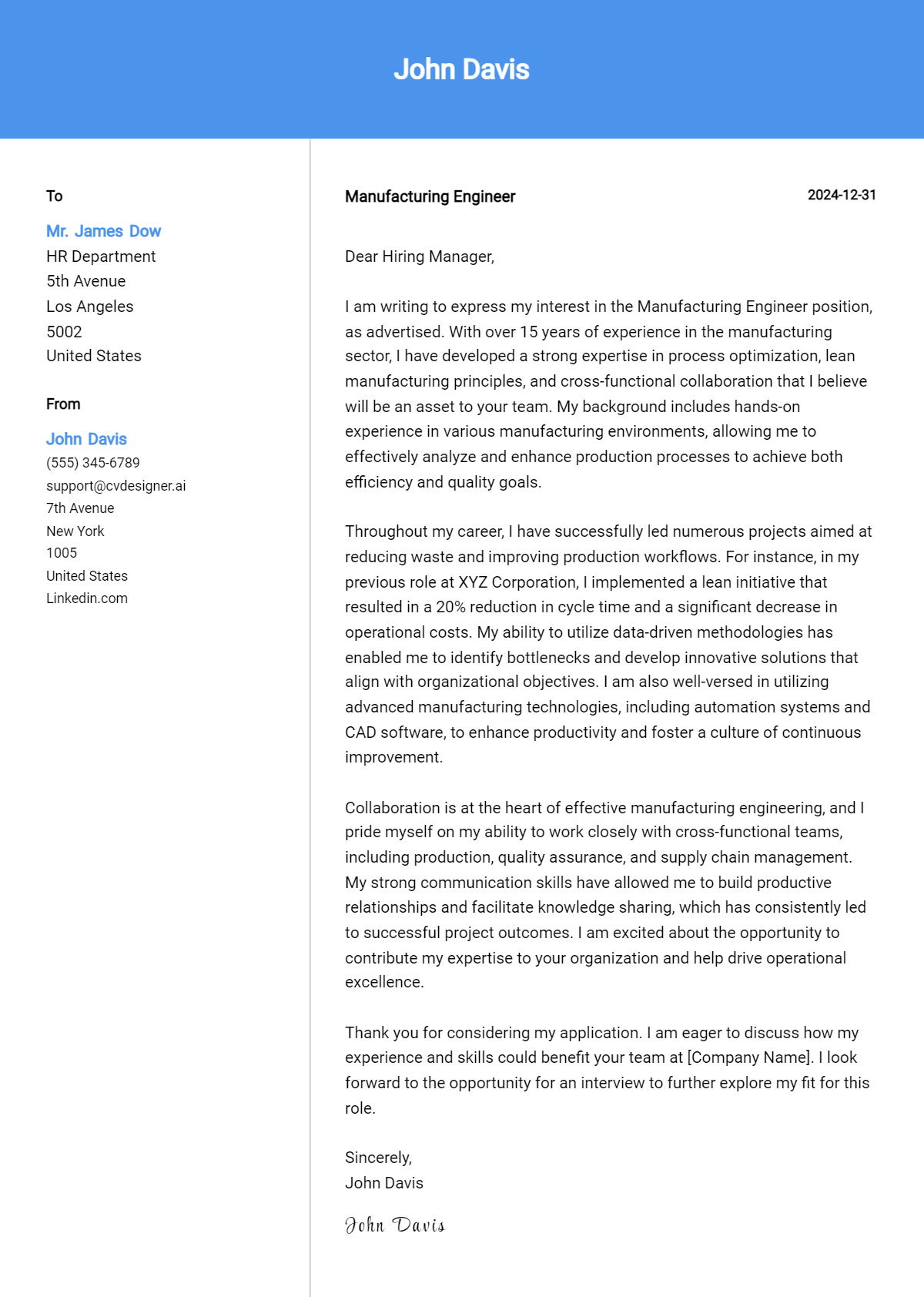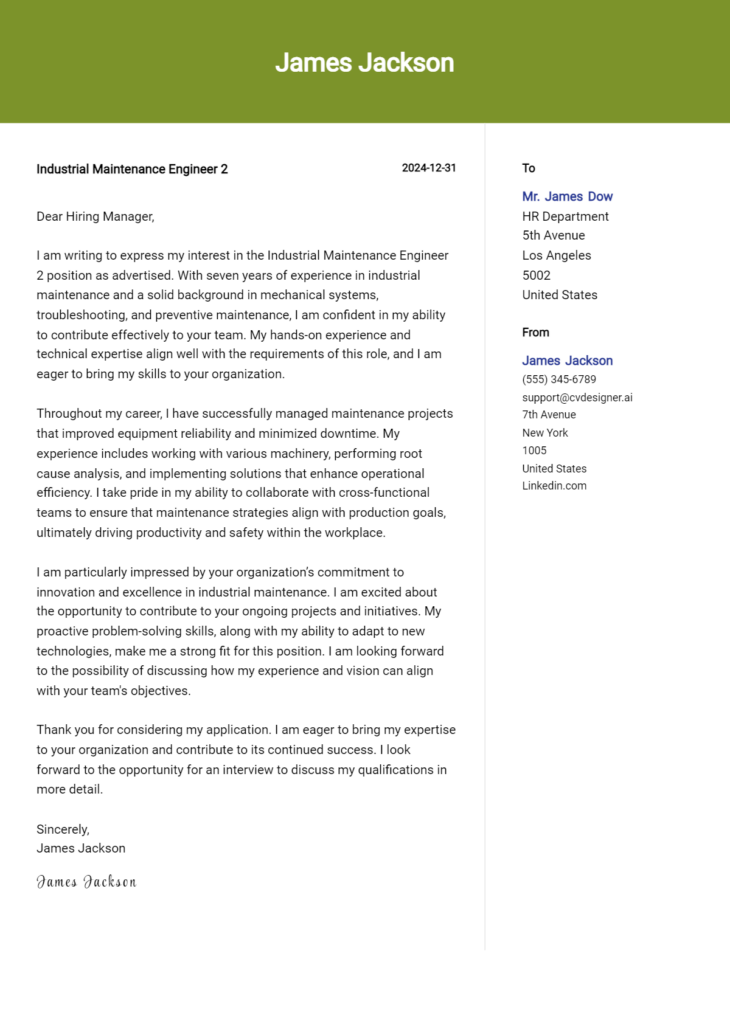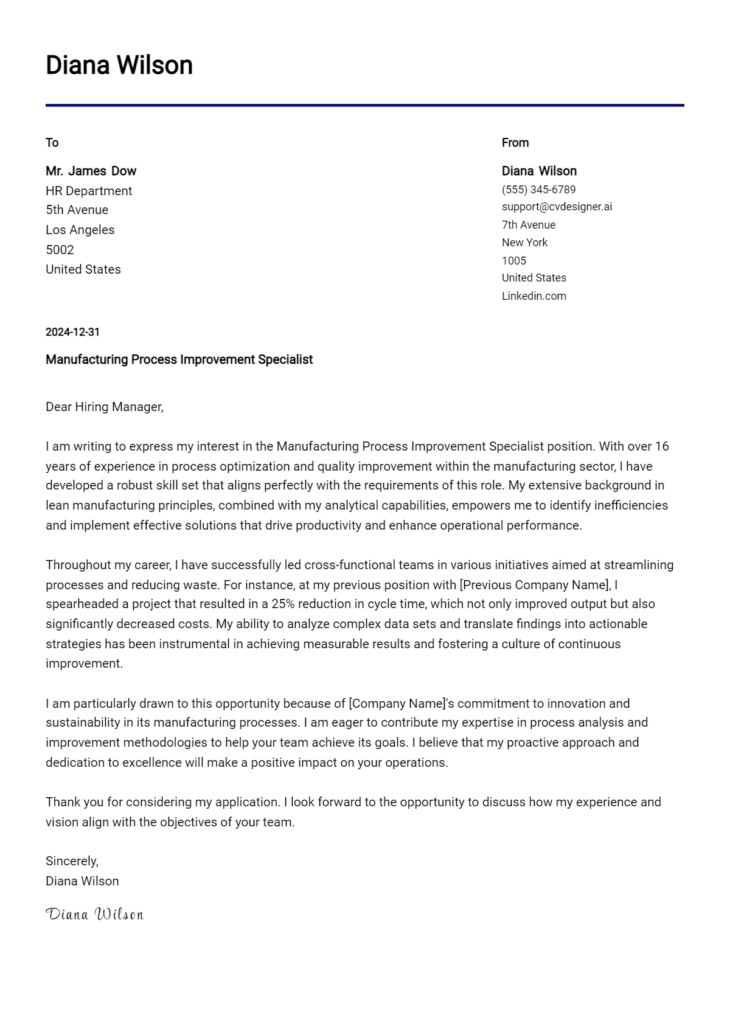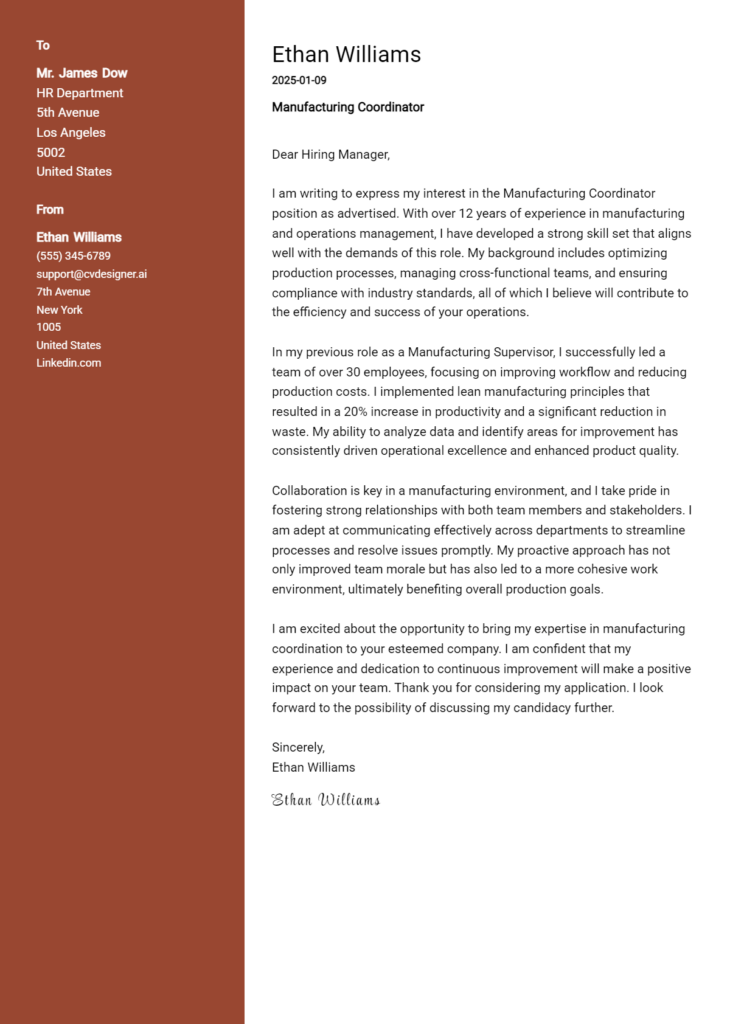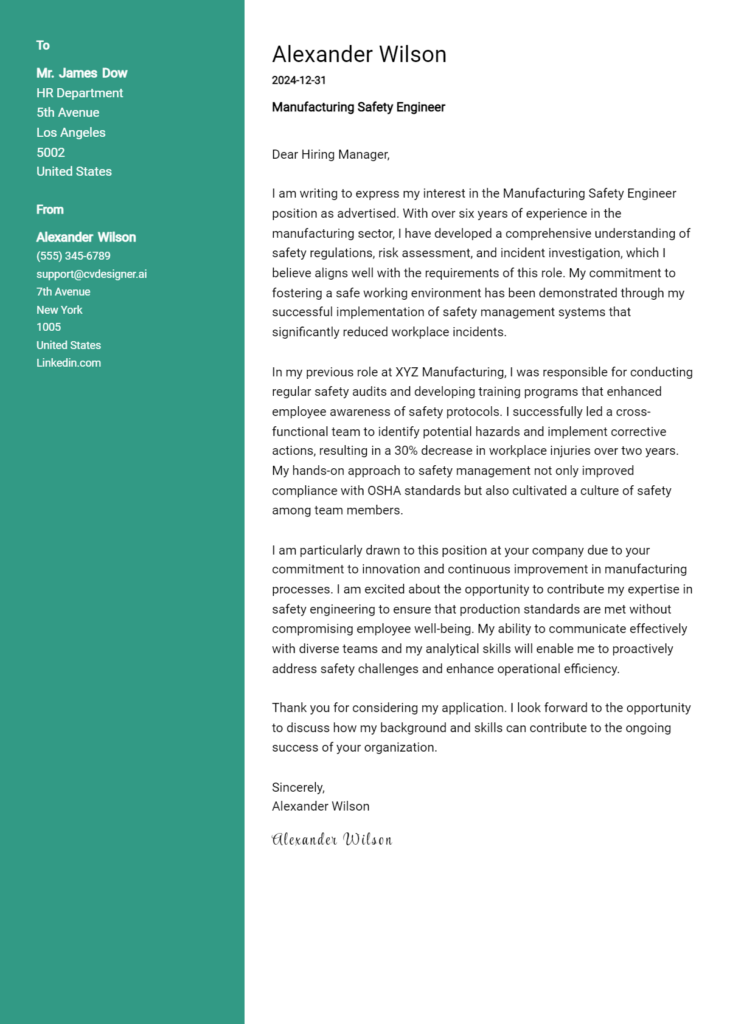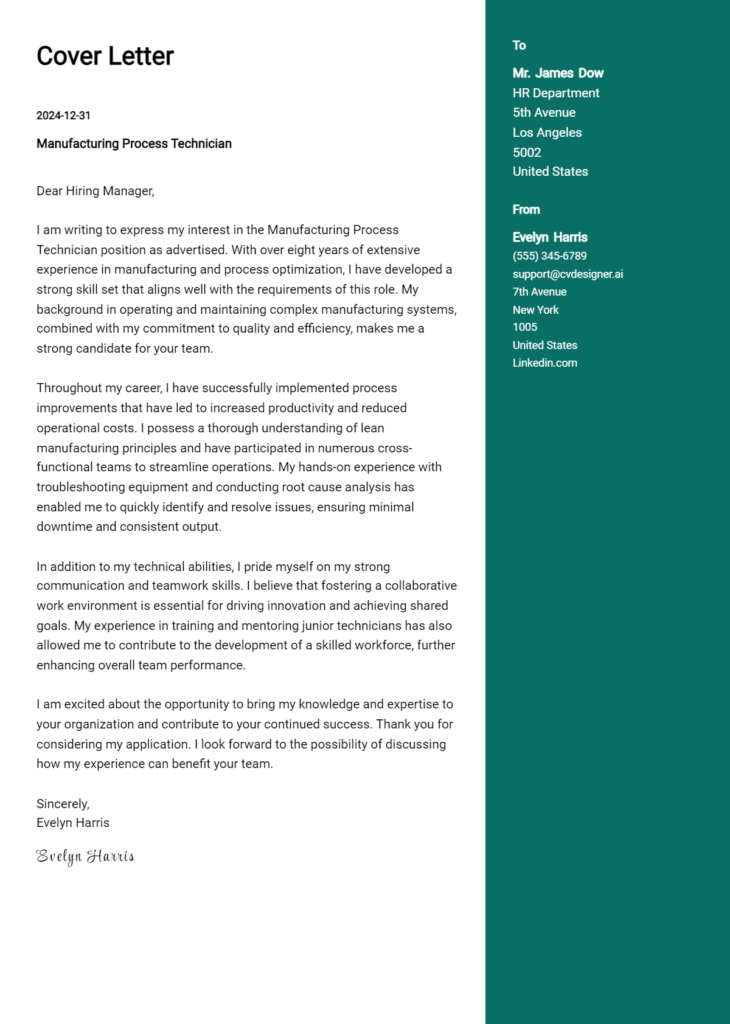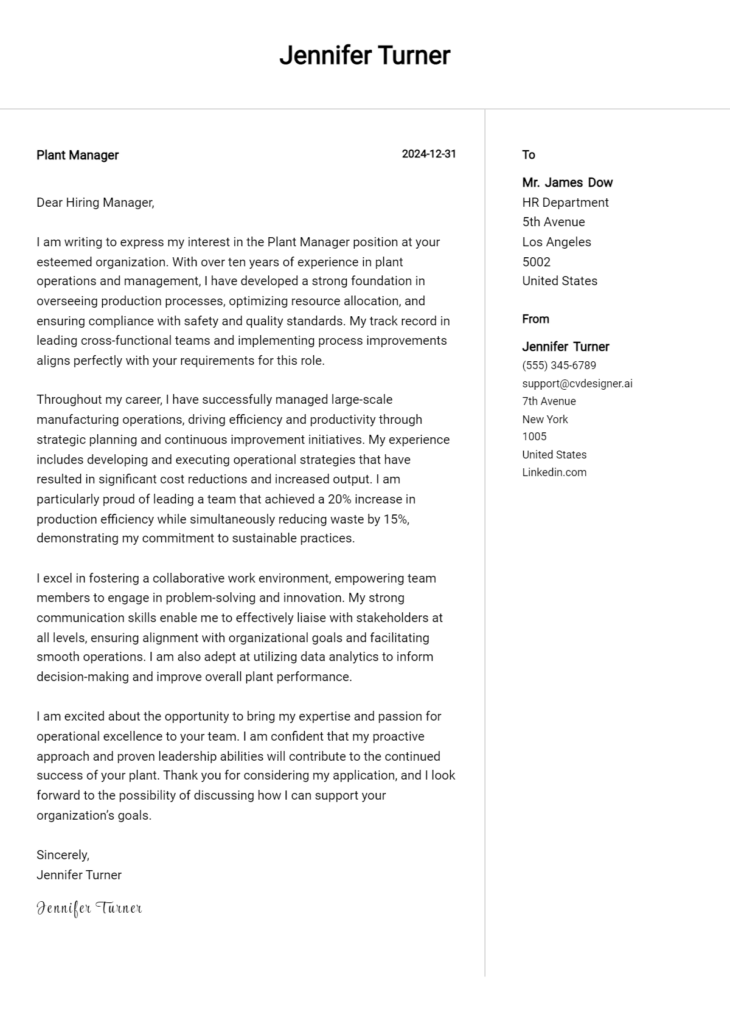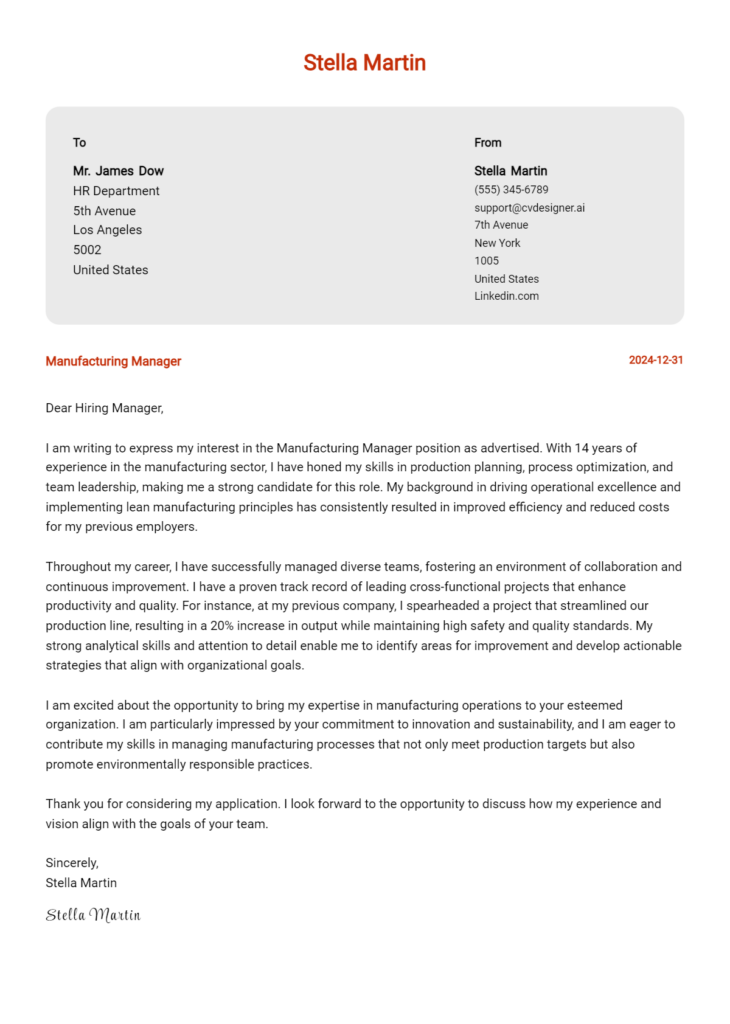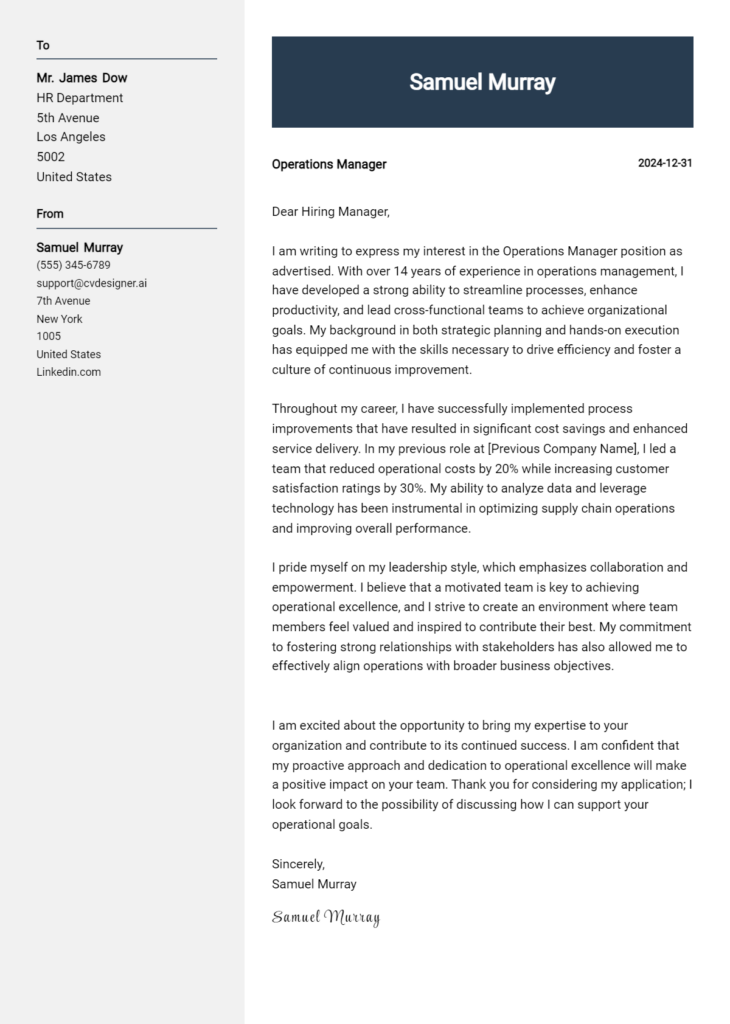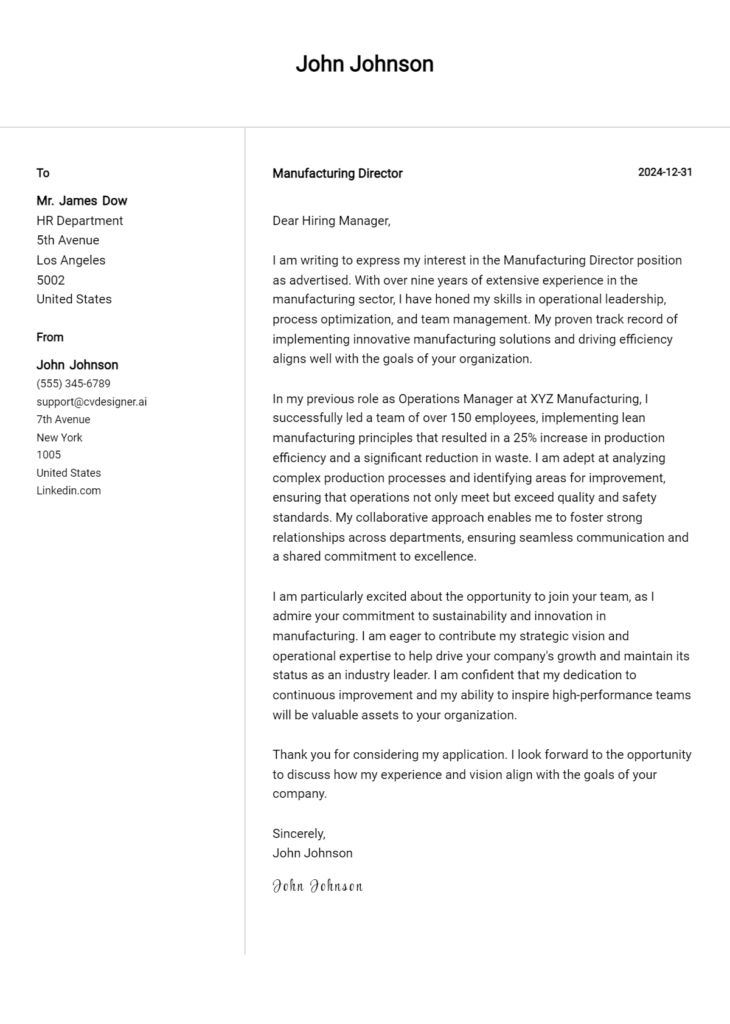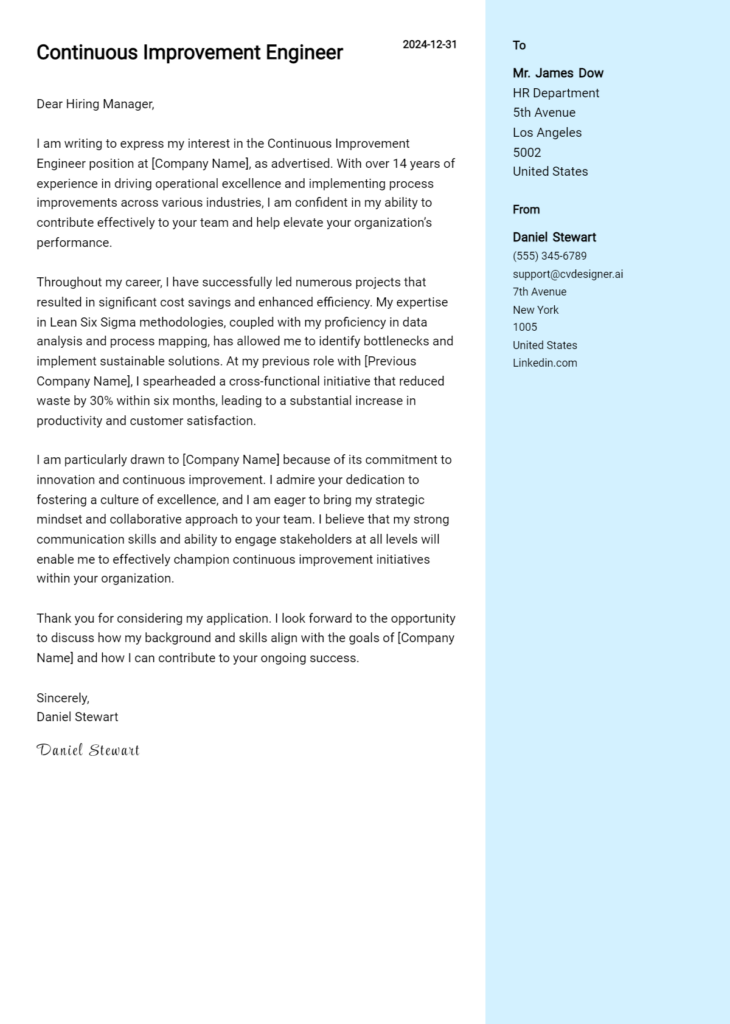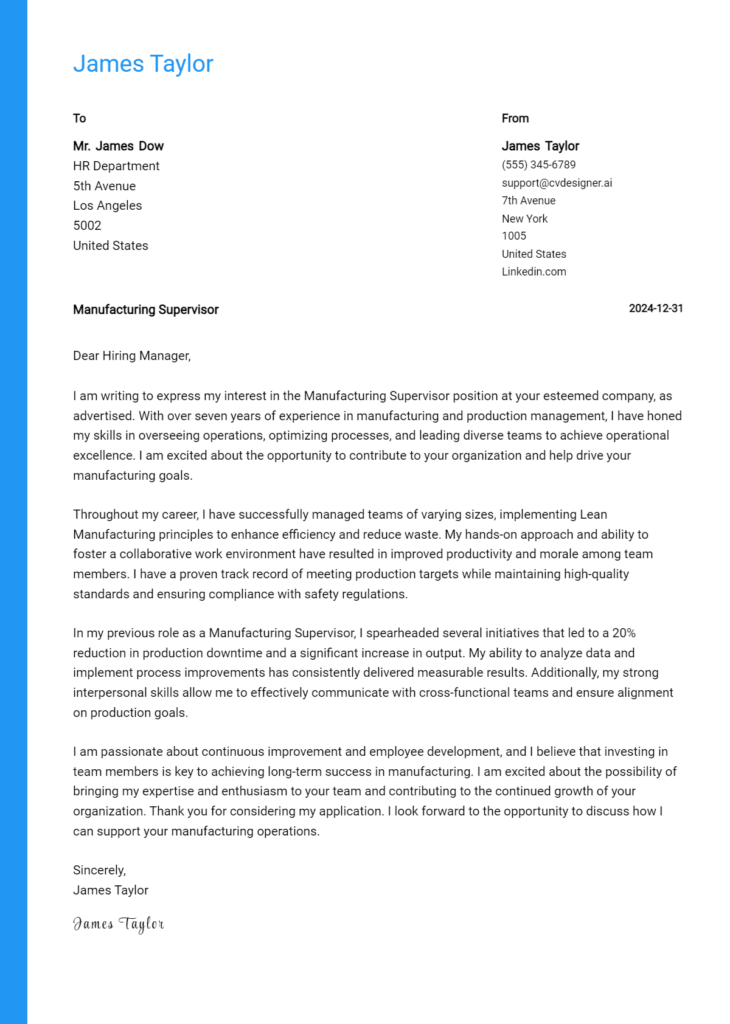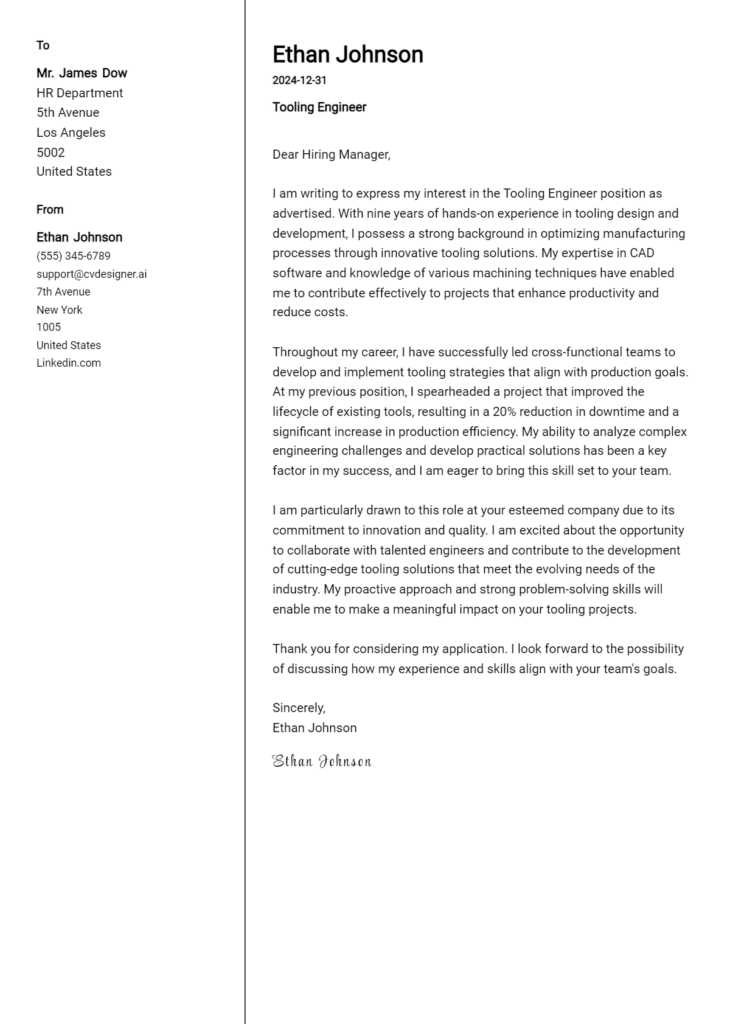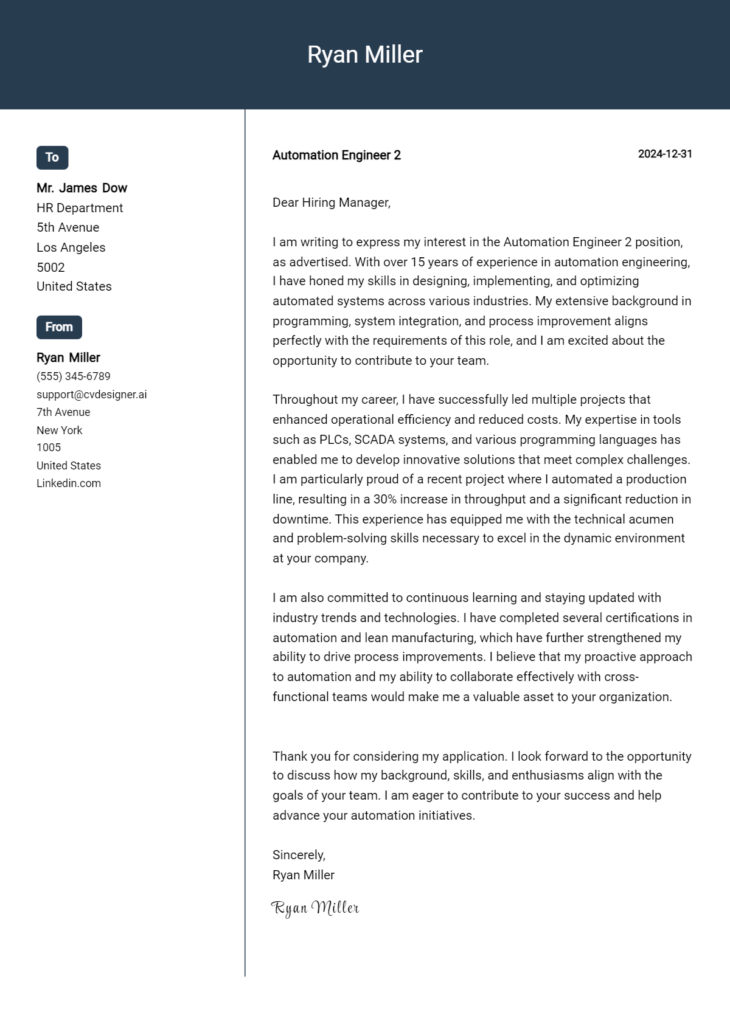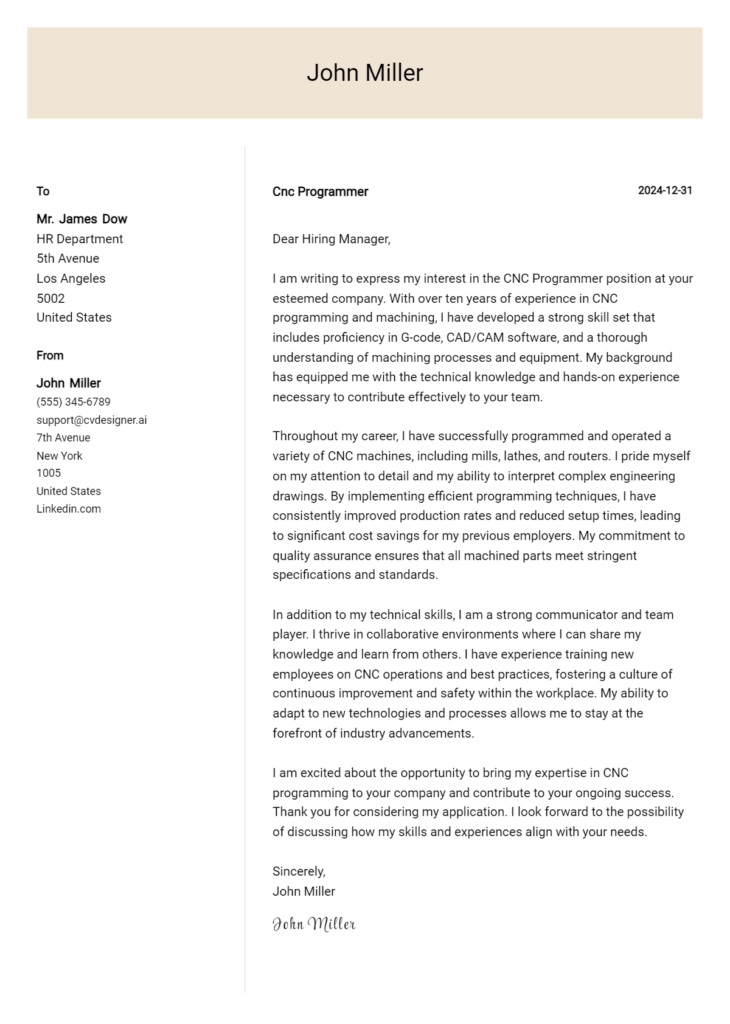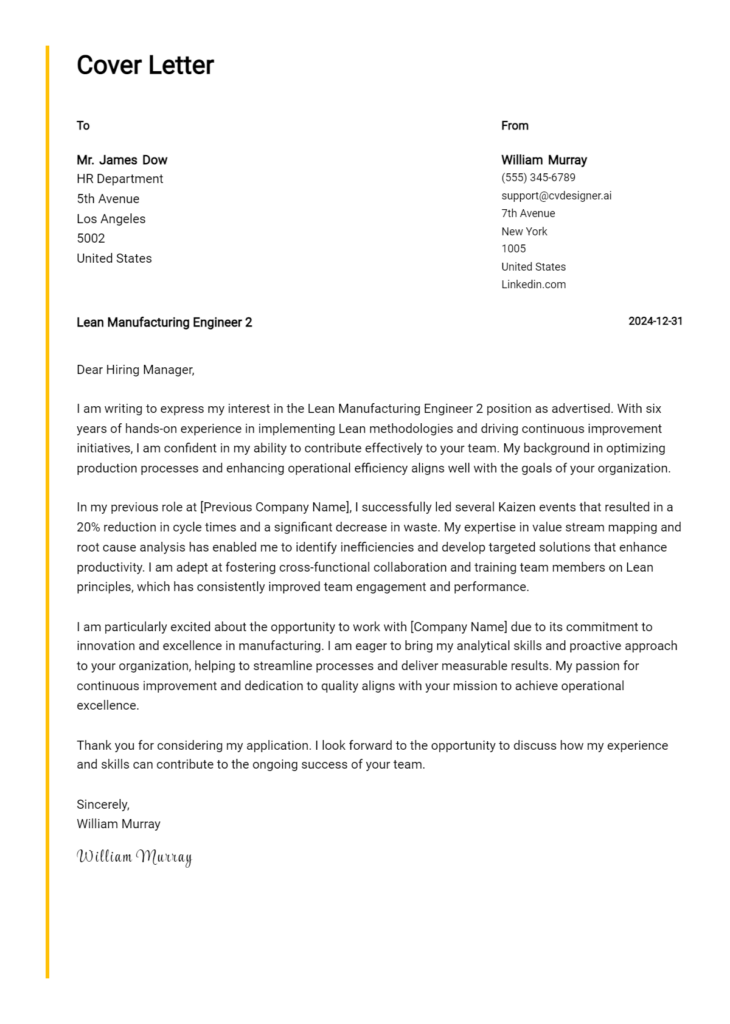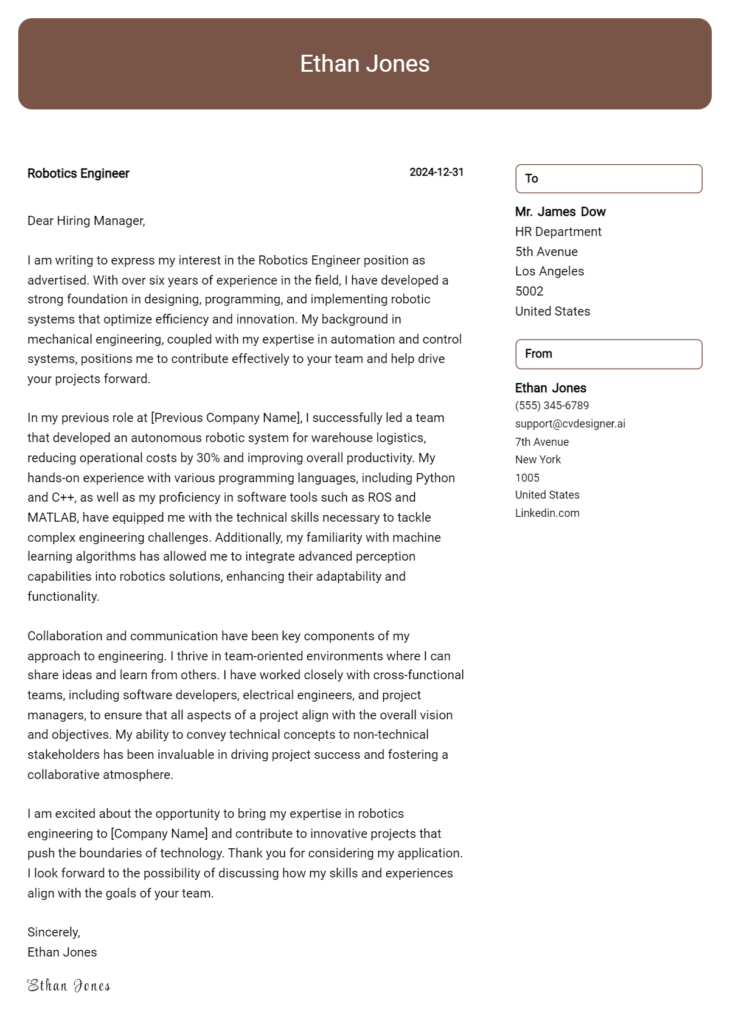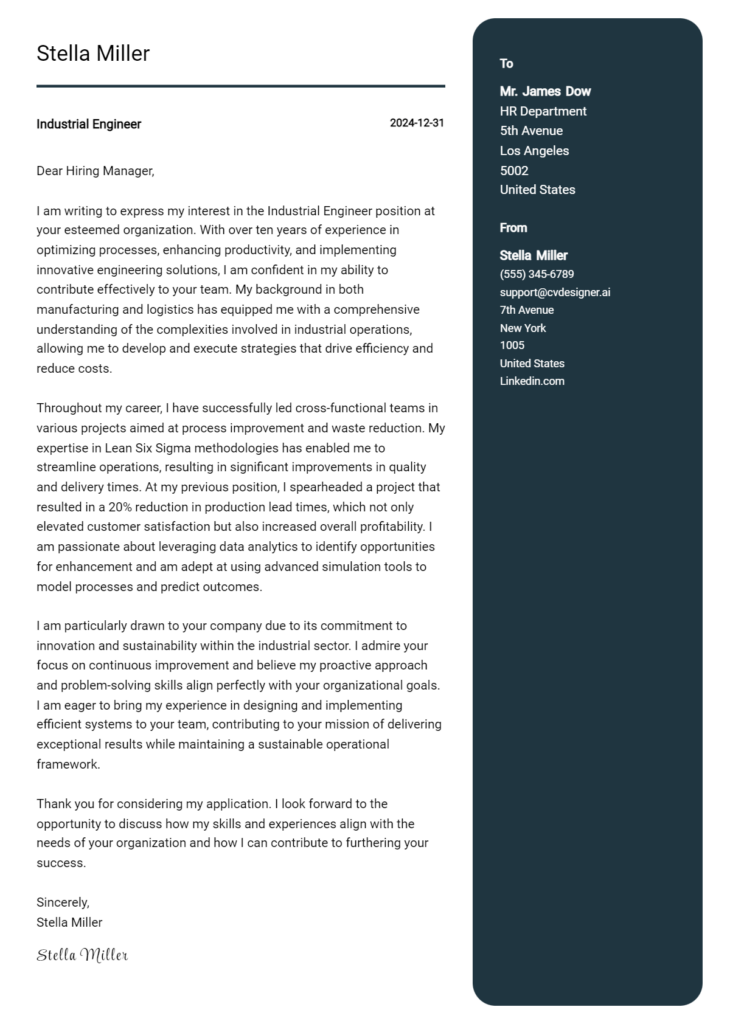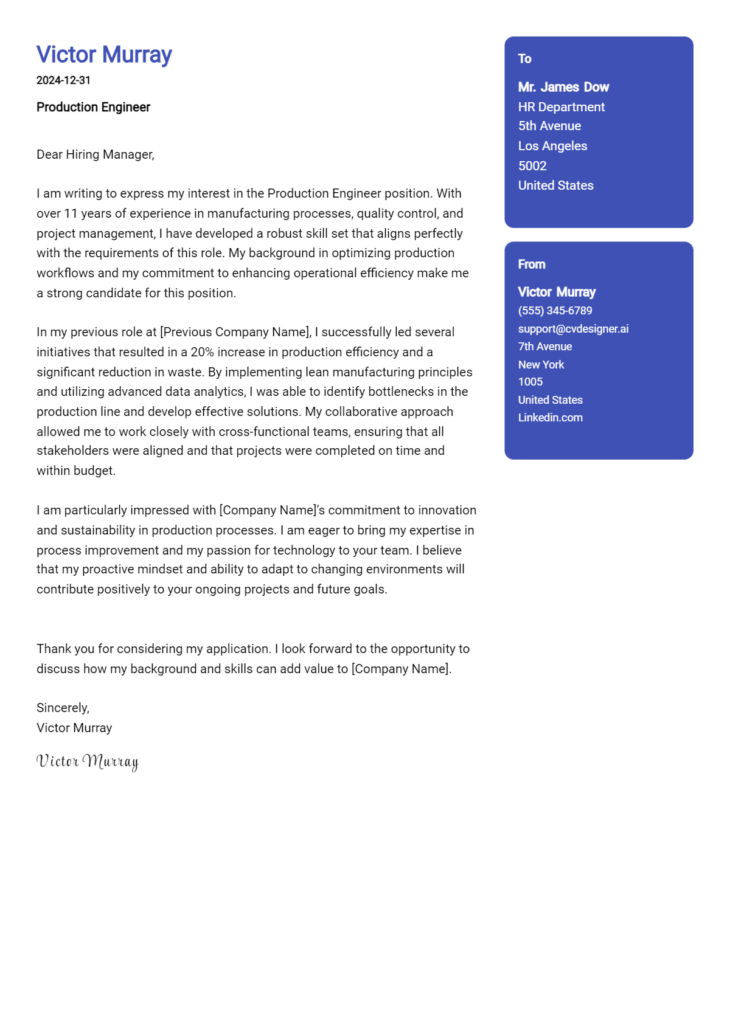Manufacturing Engineer Cover Letter Examples
Explore additional Manufacturing Engineer cover letter samples and guides and see what works for your level of experience or role.
How to Format a Manufacturing Engineer Cover Letter?
Crafting a well-structured cover letter is essential for Manufacturing Engineers, as it not only highlights your technical skills but also showcases your ability to communicate effectively—an important facet of engineering roles. The format of your cover letter serves as a reflection of your organizational skills and attention to detail, both critical qualities in the manufacturing sector. A well-organized cover letter can capture the hiring manager's attention, allowing you to present your qualifications in a clear, compelling manner.
In this guide, we will explore how to structure your cover letter, providing insights and manufacturing-specific examples to help you create a standout document.
We will cover the essential components of a professional cover letter, including:
- Cover Letter Header
- Cover Letter Greeting
- Cover Letter Introduction
- Cover Letter Body
- Cover Letter Closing
Each section plays a vital role in emphasizing your qualifications and professionalism. Let’s break down each part and discuss how to make your Manufacturing Engineer cover letter shine.
Importance of the Cover Letter Header for a Manufacturing Engineer
The cover letter header is a crucial component of any job application, particularly for a Manufacturing Engineer. It sets the tone for the entire letter and provides essential information that ensures clarity and professionalism. A well-structured header typically includes your contact information, the date, and the recipient's details. This not only makes it easy for the hiring manager to reach out to you but also demonstrates your attention to detail and organization—key traits for a successful Manufacturing Engineer.
A strong header can make a positive first impression, while a weak one may leave the recipient confused or unimpressed. Below are examples of a strong and weak cover letter header for a Manufacturing Engineer.
Strong Example
John Doe 1234 Engineering Lane Manufacturing City, ST 12345 (123) 456-7890 john.doe@email.com October 10, 2023 Hiring Manager ABC Manufacturing Inc. 5678 Industry Rd. Production Town, ST 67890
Weak Example
john d. 1234 lane city, st email date to whom it may concern
The Importance of the Cover Letter Greeting
The greeting of a cover letter serves as the first impression for potential employers and sets the tone for the rest of the correspondence. A well-crafted greeting not only demonstrates professionalism but also shows a level of personalization that can make a significant difference in the hiring process. By addressing the hiring manager directly, you convey respect and a genuine interest in the position. It’s essential to avoid generic greetings like "To Whom It May Concern," which can come off as impersonal and lazy. Instead, take the time to research the name of the recipient, whether it’s through the company website, LinkedIn, or by calling the office. This small step can highlight your dedication and attention to detail.
Here are examples of strong and weak greetings for a Manufacturing Engineer cover letter:
Strong Greeting Example
Dear Ms. Johnson,
Weak Greeting Example
To Whom It May Concern,
The Importance of a Strong Cover Letter Introduction for a Manufacturing Engineer
A well-crafted cover letter introduction is crucial for a Manufacturing Engineer seeking to make a strong impression on a hiring manager. This opening paragraph serves as the first opportunity to capture attention, express genuine interest in the role, and provide a glimpse of the candidate’s relevant skills and achievements. An engaging introduction not only sets the tone for the rest of the letter but also establishes the candidate's enthusiasm and suitability for the position. Below are examples of both strong and weak cover letter introductions, illustrating the impact of effective communication.
Strong Example
Dear [Hiring Manager's Name], As a passionate Manufacturing Engineer with over five years of hands-on experience in optimizing production processes and implementing innovative solutions, I am excited to apply for the Manufacturing Engineer position at [Company Name]. My proven track record in reducing production costs by 20% while improving product quality aligns perfectly with your commitment to operational excellence. I am eager to contribute my skills in lean manufacturing and process improvement to your esteemed team.
Weak Example
To whom it may concern, I am writing to apply for the Manufacturing Engineer job you posted. I have some experience in manufacturing, and I believe I could do the job. I hope you consider my application.
Purpose of the Cover Letter Body for a Manufacturing Engineer
The body of a cover letter for a Manufacturing Engineer serves as a critical platform for candidates to articulate their technical skills, relevant experiences, and the unique value they can bring to a prospective employer. This section allows candidates to highlight specific projects or accomplishments that demonstrate their problem-solving abilities, proficiency in manufacturing processes, and contributions to efficiency and quality improvements. By showcasing quantifiable results—such as successful project completions, cost reductions, or innovations in manufacturing techniques—candidates can effectively convey their potential impact on the company's operations and bottom line.
Strong Example
I am excited to apply for the Manufacturing Engineer position at XYZ Corp. In my previous role at ABC Manufacturing, I successfully led a project aimed at reducing production costs by 15% through the implementation of Lean Manufacturing principles. By analyzing the workflow and identifying bottlenecks, I redesigned the assembly line layout, resulting in a 20% increase in efficiency. Additionally, my collaboration with cross-functional teams on a new product launch contributed to a 30% reduction in time-to-market, demonstrating my ability to drive results while maintaining quality standards.
Weak Example
I am applying for the Manufacturing Engineer position at XYZ Corp. I have worked in manufacturing for several years and have some experience with projects. I think I can help your company be more efficient. I am familiar with Lean principles and have tried to use them in my previous job, but I don’t have specific examples to share. I’m a hard worker and am eager to learn more.
Importance of the Cover Letter Closing for a Manufacturing Engineer
The closing paragraph of a cover letter is critical as it leaves a lasting impression on the hiring manager. For a Manufacturing Engineer, this section should succinctly summarize your qualifications, express enthusiasm for the role, and clearly encourage the next steps, such as reviewing your resume or scheduling an interview. A strong closing reinforces your suitability for the position and shows your proactive attitude, while a weak closing may leave the reader uncertain about your interest or qualifications.
Strong Example
Thank you for considering my application for the Manufacturing Engineer position at [Company Name]. With my extensive background in process optimization and my passion for enhancing production efficiency, I am excited about the opportunity to contribute to your team. I look forward to discussing how my skills can benefit [Company Name] and would appreciate the chance to further explore this position in an interview. Please feel free to review my resume for additional details on my qualifications.
Weak Example
I hope you think about my application. I am interested in the Manufacturing Engineer job. If you want, you can look at my resume. Thanks.
Crafting an effective cover letter is crucial for aspiring Manufacturing Engineers to stand out in a competitive job market. A well-written cover letter not only highlights your technical skills and problem-solving abilities but also showcases your understanding of the software development life cycle (SDLC), teamwork experience, and commitment to continuous learning. Below are some tips to help you create a compelling cover letter that resonates with potential employers.
Tips for Crafting a Cover Letter for Manufacturing Engineer
Highlight Your Technical Skills
Start by emphasizing your technical expertise relevant to manufacturing engineering. Mention specific software tools, methodologies, or manufacturing processes you are proficient in, such as CAD software, Six Sigma, or Lean Manufacturing principles. Providing concrete examples of how you applied these skills in previous roles can make a strong impression.Demonstrate Problem-Solving Abilities
Manufacturing engineers often face complex challenges that require innovative solutions. Share an example of a problem you encountered in a past project and describe the steps you took to resolve it. This not only showcases your analytical skills but also your ability to think critically under pressure.Showcase Your Knowledge of SDLC
Since many manufacturing projects involve software systems, it's essential to demonstrate your understanding of the software development life cycle. Briefly describe your experience with SDLC phases, such as requirements gathering, design, implementation, and testing, and how you have applied this knowledge in a manufacturing context.Emphasize Teamwork and Collaboration
Manufacturing engineering often involves cross-functional teams. Highlight your experience working collaboratively with other departments, such as design, quality assurance, and production. Discuss how your contributions helped foster a productive team environment and led to successful project outcomes.Express a Passion for Continuous Learning
The manufacturing industry is constantly evolving with new technologies and methodologies. Convey your enthusiasm for continuous learning by mentioning relevant certifications, courses, or workshops you have completed. This not only reflects your commitment to professional growth but also indicates that you are adaptable and open to new ideas.
By integrating these tips into your cover letter, you can effectively communicate your qualifications and enthusiasm for the role of Manufacturing Engineer. For additional guidance, consider using cover letter templates or a cover letter builder to streamline the writing process.
Common Mistakes to Avoid in a Manufacturing Engineer Cover Letter
Avoiding common mistakes in your cover letter is crucial for making a strong impression as a Manufacturing Engineer. A well-crafted cover letter can set you apart from other candidates, while errors can undermine your qualifications. Here are some frequent pitfalls to watch out for:
Generic Greetings: Using "To Whom It May Concern" can make your letter seem impersonal. Always try to find the hiring manager’s name for a personalized touch.
Focusing on Responsibilities Instead of Achievements: Simply listing your job duties can be uninspiring. Instead, highlight specific achievements and how they contributed to your previous employers’ success.
Neglecting to Tailor Content: Sending a generic cover letter that doesn’t address the specific job and company can hurt your chances. Research the organization and customize your letter accordingly.
Overly Complex Language: Using jargon or technical terms can alienate readers. Aim for clear and concise language that effectively communicates your qualifications.
Lack of Structure: A disorganized letter can be difficult to read. Follow a clear cover letter format to enhance readability and professionalism.
Ignoring the Job Description: Failing to reference the job description can make it seem like you’re not genuinely interested. Make sure to align your skills with the requirements outlined in the posting.
Typos and Grammatical Errors: Mistakes can reflect poorly on your attention to detail. Always proofread and consider having someone else review your letter before submission.
By steering clear of these common mistakes, you can create a compelling cover letter that showcases your skills and enthusiasm for the role. For inspiration, check out various cover letter examples that can guide your writing process.
Cover Letter FAQs for Manufacturing Engineer
What should I include in my cover letter as a Manufacturing Engineer?
In your cover letter, focus on highlighting your technical skills, experience with manufacturing processes, and problem-solving abilities. Begin with a strong introduction that expresses your interest in the position and how it aligns with your career goals. Use specific examples to demonstrate your experience with tools like CAD software, Lean manufacturing, or Six Sigma methodologies. Additionally, mention any successful projects or improvements you’ve implemented in previous roles. Finally, convey your enthusiasm for the company and how your skills will contribute to their goals and values.
How can I make my cover letter stand out?
To make your cover letter stand out, personalize it for each application. Research the company’s culture, values, and recent projects, and reference them in your letter. Use quantifiable achievements to showcase your impact in previous roles, such as reducing production costs or improving efficiency. A compelling narrative that connects your professional journey to the job requirements can also capture the employer's attention. Lastly, maintain a professional tone while allowing your personality to shine through, making your letter both engaging and memorable.
Should I include technical jargon in my cover letter?
Yes, including relevant technical jargon can be beneficial in your cover letter, especially for a Manufacturing Engineer position. However, ensure that the terminology is appropriate for the audience. If you know the hiring manager will understand specific terms related to manufacturing processes, quality control, or engineering software, feel free to use them. Just remember to balance technical language with clear explanations to avoid alienating readers who may not have a deep engineering background. Your goal is to demonstrate expertise without overwhelming the reader.
How long should my cover letter be?
Your cover letter should ideally be one page long, typically consisting of three to four paragraphs. Aim for a word count between 250 to 400 words. This length allows you to adequately introduce yourself, highlight your relevant skills and experiences, and express your enthusiasm for the position without overwhelming the reader. Make sure to keep your writing concise and focused, avoiding unnecessary filler. A well-structured cover letter that respects the reader's time is more likely to make a positive impression.
Build your Cover Letter in minutes
Use an AI-powered cover letter builder and have your letter done in 5 minutes. Just select your template and our software will guide you through the process.

